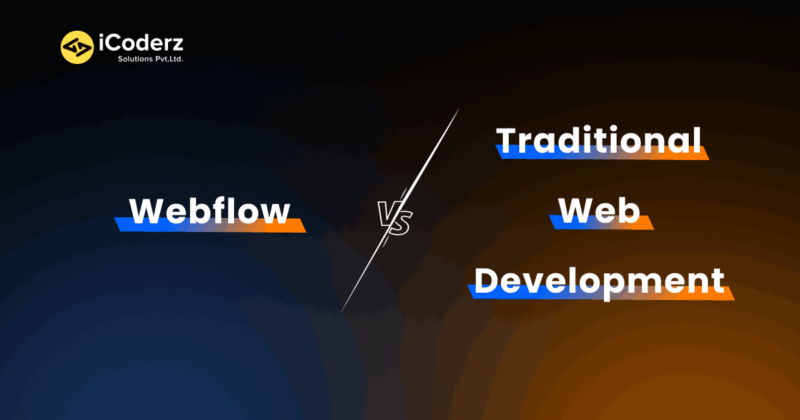Table of Contents
- What is Webflow?
- What are the Key Features of webflow?
- Advantages of Webflow VS Traditional Web Development
- Disadvantages of Webflow Compared to Traditional Web Development
- When Should You Choose Each Approach?
- Tips for Choosing the Right Web Development Approach for Your Project
- Frequently Asked Questions ( FAQ’s )
- Conclusion
With the increasing popularity of web-based tools, many companies are turning to software solutions like Webflow to streamline their web development process. But is this the best option for you? This article will compare Webflow VS Traditional Web Development and help you decide which approach is most suitable for your project.
As the internet continues to grow and evolve, so does the need for web development skills. Whether you want to build a website from scratch or improve your existing site, learning web development can help you create a better experience for your users.
There are many reasons why Website Development is important, but here are four of the most important ones:
1. Helps you understand how users interact with websites
2. Enables you to create a better user experience
3. It Allows you to make your website more responsive and faster
4. Makes it possible to integrate new technologies into your website
What is Webflow?
Webflow is a website builder that allows users to create custom websites without having to write code. Webflow also includes hosting, e-commerce, and CMS features.
Traditional web development is the process of creating a website from scratch using coding languages such as HTML, CSS, and JavaScript. Traditional web development can be more time-consuming and complex than using a website builder like Webflow.
What are the Key Features of webflow?
- Drag-and-Drop Interface: Webflow provides a visual drag-and-drop interface that allows users to design and build websites without needing to write any code.
- Pre-Designed Templates: Webflow offers a wide range of pre-designed templates and themes that users can customize to create a unique website.
- Responsive Design: Webflow ensures that all websites created using its platform are optimized for all devices, including mobile phones, tablets, and desktops.
- Web Animations: Webflow provides a range of animation tools that allow users to create engaging and interactive designs for their websites.
- Customizable Interactions: Webflow ensures that all websites created using its platform are optimized for all devices, including mobile phones, tablets, and desktops.
- Users: Users can create custom interactions and animations that respond to user interactions, such as mouse clicks or scroll events.
- CMS: Webflow provides a built-in content management system (CMS) that allows users to easily create, edit, and publish content on their websites.

- E-commerce: Webflow’s e-commerce tools allow users to create online stores with customizable product pages, shopping carts, and checkout processes.
- SEO Optimization: Webflow provides a range of SEO optimization tools, including metadata editing, sitemap creation, and Google Analytics integration.
- Custom Code: Users can add custom code to their Webflow projects, allowing for greater flexibility and advanced functionality.
- Team Collaboration: Webflow provides tools for team collaboration, including shared design libraries, commenting, and version control.
- Hosting: Webflow offers built-in hosting for all websites created using its platform, which includes free SSL certificates and automatic backups.
- Integrations: Webflow can be integrated with a wide range of third-party services and tools, including Zapier, Google Analytics, and Mailchimp.
- Security: Webflow provides advanced security features, including SSL encryption, password protection, and two-factor authentication.
- Customer Support: Webflow provides customer support through its help center, community forum, and email support.
- Custom Domains: Webflow allows users to use their custom domains with their websites or purchase domains directly through the Webflow platform.
- Pricing: Webflow offers a range of pricing plans to suit different needs, including a free plan, a basic plan for personal websites, and more advanced plans for businesses and e-commerce websites.
Overall, Webflow provides a powerful and flexible platform for building websites, with a wide range of features to suit different needs and skill levels. Whether you’re a beginner or an experienced web developer, Webflow’s drag-and-drop interface, customizable templates, and advanced functionality make it a popular choice for website design and development.
Advantages of Webflow VS Traditional Web Development
Here are some potential advantages of using Webflow over traditional web development:
- Faster development time since Webflow provides a visual drag-and-drop interface that allows for rapid prototyping and design iteration.
- Lower cost for smaller or simpler projects since Webflow’s pricing structure is designed to be accessible and affordable for small businesses and individuals.
- No need for coding or programming knowledge, as Webflow’s design tools are intuitive and user-friendly, making it easy to create a professional-looking website without technical expertise.
- Built-in hosting and content management system, which can simplify the process of launching and maintaining a website, particularly for those with limited technical knowledge or resources.
- Advanced functionality and integrations, including the ability to create complex animations, interactions, and e-commerce features without needing to write custom code.

Disadvantages of Webflow Compared to Traditional Web Development
Here are some potential disadvantages of using Webflow compared to traditional web development:
- Limited flexibility in terms of design and customization since Webflow has its own set of design tools and templates.
- Dependence on Webflow’s hosting services can lead to potential downtime and limited control over server configurations.
- Limited ability to implement custom code or complex functionality, as Webflow is designed for simpler websites and may not offer as much flexibility for advanced programming.
- Potential difficulty in integrating with third-party tools or software, as Webflow’s ecosystem may be more limited than traditional web development options.
- Higher costs, as Webflow’s pricing structure, may be more expensive than traditional web development, particularly for larger or more complex projects.
When Should You Choose Each Approach?
The answer to this question depends on a variety of factors, including the scope and scale of your project, your timeline, your budget, and your team’s skillset.
If you have a small project with a limited scope and a tight timeline, then Webflow may be the right approach for you. Webflow is a visual drag-and-drop platform that makes it easy to create responsive websites without writing code. This means that you can get a website up and running quickly without having to invest in learning how to code.
If you have a larger project with a more complex scope, then traditional web development may be the better approach. Traditional web development involves writing code from scratch (or using a framework like Laravel or Ruby on Rails). This gives you more control over the look and feels of your website, as well as its functionality. It also allows you to scale your website more easily as your business grows. However, it does require more time and effort to get started, and you’ll need to invest in learning how to code (or hire someone who already knows how).
Ultimately, the best approach for your project will depend on your specific needs and goals. If you’re not sure which approach is right for you, reach out to a web development agency or consultant for help making the decision.
Tips for Choosing the Right Web Development Approach for Your Project
There are a few things to consider when deciding which web development approach is right for your project.
1. Consider your project goals: If you’re looking for a simple, static website, then traditional web development may be a good option. However, if you’re looking for a more complex, interactive website, then Webflow may be a better option.
2. Consider your budget: Traditional web development can be more expensive than using Webflow, so if budget is a concern, then Webflow may be the better option.
3. Consider your timeline: If you’re working on a tight deadline, then Webflow may be the better option since it doesn’t require as much time to build a website.
4. Consider your level of expertise: Do you have experience with coding and web development? If not, then using Webflow may be a better option since it’s easier to use and doesn’t require any coding knowledge.
5. Consider your team’s skillset: Do all members of your team have experience with coding and web development? If not, then using Webflow may be a better option since it’s easier to use and doesn’t require any coding knowledge.
Frequently Asked Questions ( FAQ’s )
1. What is the difference between Webflow and traditional web development?
Answer: Webflow is a website builder and content management system that provides a visual drag-and-drop interface for building websites, while traditional web development involves writing custom code using programming languages such as HTML, CSS, and JavaScript. Webflow also provides built-in hosting and a content management system, while traditional web development requires users to manage their hosting and server configurations.
2. Is Webflow easier to use than traditional web development?
Answer: Webflow can be easier to use than traditional web development for beginners and those who are not familiar with coding, as it provides a visual drag-and-drop interface and pre-designed templates. However, for those with experience in programming, traditional web development may provide more control and flexibility in terms of design and functionality.
3. Can Webflow be used for large or complex projects?
Answer: While Webflow can be used for larger or more complex projects, it may have limitations in terms of design flexibility, customization, and advanced functionality. Traditional web development may be a better option for large or complex projects that require custom coding, third-party integrations, or specific server configurations.
4. What are the benefits of using traditional web development over Webflow?
Answer: Traditional web development provides complete control over design, functionality, and server configurations, allowing for custom coding and advanced integrations. It may also be more cost-effective for larger or more complex projects, as the costs of using a website builder like Webflow can increase as the complexity and size of the project grow.
Conclusion
No matter which web development approach you to choose, there is no doubt that it will impact your project’s success. Webflow VS traditional web development are both powerful tools for creating websites, but each has its own unique set of advantages and disadvantages. Before deciding which one is right for your project, take the time to consider all of the pros and cons so that you can find the best solution for your needs. With careful research and thoughtful planning, you should be able to create a website that meets all of your requirements without compromising quality or efficiency.





